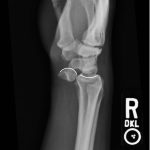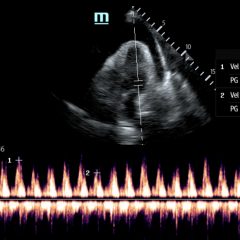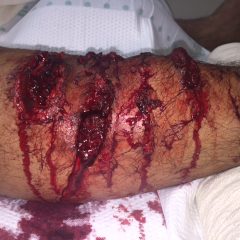Lunate Dislocation
History of present illness:
A 28-year-old right-handed male presented to the ED after he fell onto his outstretched right hand after being thrown from his motorcycle at highway speeds. He complained of right wrist pain. On exam, he had a visible deformity of his right wrist with diffuse tenderness to palpation over the wrist. Sensation was intact and he had 2+ radial and ulnar pulses.
Significant findings:
Plain film of the right wrist showed the classic “spilled teacup” consistent with a lunate dislocation. There is a loss of the normal articulation between the distal radius and lunate (white curved highlights represent expected points of articulation).
Discussion:
The most common mechanism leading to a dislocation of lunate is a fall onto an outstretched hand with the wrist in extension. Damage to the ligamentous infrastructure (commonly the dorsal radiolunate ligament) causes destabilization.1 Lunate dislocations are distinguished from perilunate dislocations by assessing for the preservation of the articulation between the lunate and distal radius. In lunate dislocations, this articulation is disrupted leading to the classic “spilled teacup” appearance as seen above. However, if the articulation between the distal radius and lunate is preserved, but there is displacement of the carpal bones (eg, scaphoid, triquetrum, etc), then the dislocation is referred to as a perilunate dislocation.
Plain film radiography oriented in the lateral view is typically the first-line modality for diagnosis. However, advanced imaging such as computed tomography or magnetic resonance imaging may be required to rule out fracture.
It is important to keep in mind that the lunate receives its blood supply distally from the anterior interosseous artery; therefore, any injury (eg, fracture) that disrupts perfusion places the patient at risk for avascular necrosis.2 As with all orthopedic upper extremity injuries, a thorough neurologic exam should be performed assessing for injury to the median, radial, and ulnar nerves. After diagnosis, an emergent consult to a hand specialist should be obtained because surgery is required for all forms of lunate dislocations. Prior to surgery, one may be placed in a posterior long arm splint. 3
Topics:
Lunate dislocation, orthopedics, ortho, hand.
References:
- Garcia-Elias M. Carpal instability. In: Wolfe SW, Hotchkiss RN, Pederson WC, Kozin SH, eds. Green’s Operative Hand Surgery. 6th Philadelphia, PA: Elsevier; 2011:483.
- WilkeB, Kakar S. Delayed avascular necrosis and fragmentation of the lunate following perilunate dislocation. Orthopedics. 2015;38(6):e539-542. doi: 10.3928/01477447-20150603-92
- Budoff JE. Treatment of acute lunate and perilunate dislocations. J Hand Surg Am. 2008;33(8):1424. doi: 10.1016/j.jhsa.2008.07.016




